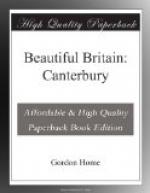Scarcely two months after Henry’s penance the splendid choir of the Cathedral caught fire, and the townsfolk, in a state between grief and rage, found themselves unable to stay the progress of the flames until nearly everything that could burn had vanished. The nave suffered less than Conrad’s splendid choir, and in that less ruined portion of the building a temporary altar was erected. But for this fire it might have been possible for the modern pilgrim to see the building as it appeared during the stirring events just recounted; for, notwithstanding the wealth of the monastery of Christ Church, it would have probably been thought desirable to retain the fabric as much as possible as it appeared in Becket’s time. The fire came, however, and the choir was to a great extent rebuilt, but fortunately the chapels were only slightly affected.
After careful inquiry the monastery decided to employ William of Sens as architect for the reconstruction, and the excellent work of this clever Norman craftsman lives to-day in the eastern portion of the cathedral church. He set to work soon after the fire; but, after four years of labour, was so much injured by a fall from the scaffolding that he was obliged to abandon his unfinished work and return to his native Normandy. Upon an Englishman named William devolved the task of completing the work.
Either following the Frenchman’s plans or adapting them to his own ideas, he finished the eastern parts of the church as they stand to-day in the year 1184. To one or both of these architects is due the unusual device of narrowing the choir to avoid altering the site of the Trinity Chapel of Becket’s time. When the reconstruction of Conrad’s Norman choir began, the Gothic style was just beginning to appear—an incipient tendency towards a pointed arch here and there which grew into what is called the Transitional Period; and to this style—in between the Romanesque semicircular arch, with its accompanying massiveness, and the first style of Gothic known as Early English, distinguished by the pointed arch, detached pillars decorating the triforium and clerestory, and elaborate mouldings and capitals—the choir belongs.
When the whole of the east end of the cathedral was finished, nearly two centuries elapsed before any further change took place beyond the beginning of the chapter-house. At the commencement of that period, however, one of Canterbury’s most magnificent scenes of ecclesiastical pomp occurred in connection with the remains of Becket. The summer of 1220 saw the completion of the new shrine, and on July 7, the translation of the saint’s remains was accomplished amid scenes of the most astonishing splendour, described by those who were present as being without a parallel in the history of England, the crowds including people from many foreign countries. Money was spent so lavishly on the entertainment of the innumerable persons of distinction who were present or took part in the




